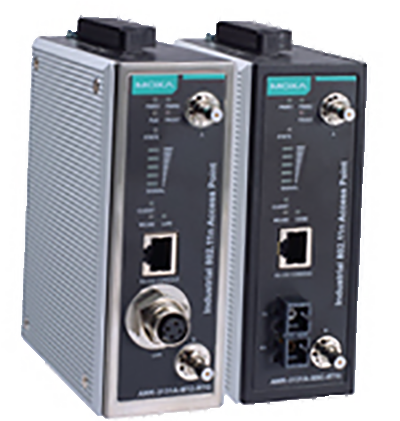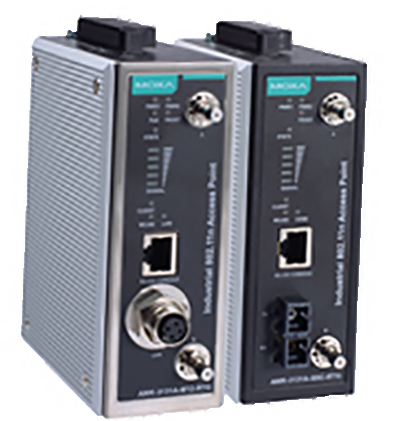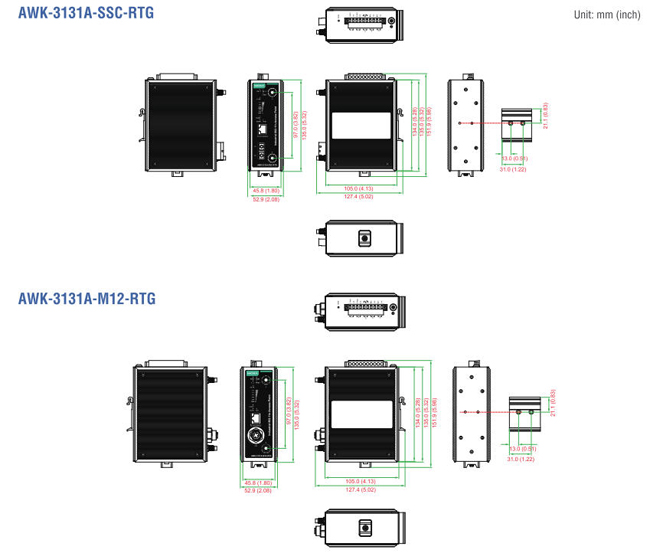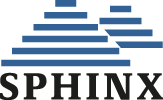MOXA AWK-3131A-RTG Series
Industrial IEEE 802.11a/b/g/n wireless AP/client




- IEEE 802.11a/b/g/n compliant
- M12 anti-vibration connectors (AWK-3131A-M12-RTG)
- SC optical fiber connection (AWK-3131A-SSC-RTG)
- QoS (WMM) and VLAN for efficient network traffic
- Controller-based Turbo Roaming (handover time < 50 ms @ 3 channels, WPA2) - available only when used with the WAC-1001 or WAC-2004
- Complies with all EN 50155 mandatory test items
- -40 to 75°C operating temperature range (T models)
The AWK-3131A-RTG 3-in-1 industrial AP/client devices are designed specifically for train-to-gound communication while moving at speeds of up to 120 km/h. The AWK-3131A-RTG complies with a portion of EN 50155 specifications, covering operating temperature, power input voltage, surge, ESD, and vibration, making the AWK-3131A-RTG suitable for a variety of industrial applications. Installation is easy, with either DIN-rail mounting or distribution boxes, and the DIN-rail mounting capability, wide operating temperature range, and IP30 housing with LED indicators make the AWK-3131A-RTG a convenient yet reliable solution for any rolling stock application.
Advanced Security
- 64-bit and 128-bit WEP (Wired Equivalent Privacy)
- Enable/disable SSID broadcasts
- WPA/WPA2 (Wi-Fi Protected Access) and 802.11i support
- IEEE802.1X/RADIUS support
- Powerful filters for access control
Specifications for Train-to-Ground Applications
- Client-based Turbo Roaming handover time < 150 ms @ 3 channel with WPA2
- Controller-based Turbo Roaming handover time (available only when used with the WAC-1001 or WAC-2004) < 50 ms @ 3 channels with WPA2
- Multiple roaming parameters for different installation structures and antenna types

| • WLAN Interface | |
| Standards | IEEE 802.11a/b/g/n for Wireless LAN IEEE 802.11i for Wireless Security IEEE 802.3 for 10BaseT IEEE 802.3u for 100BaseTX IEEE 802.3af for Power-over-Ethernet IEEE 802.1Q for VLAN |
| Spread Spectrum and Modulation (typical) | • DSSS with DBPSK, DQPSK, CCK • OFDM with BPSK, QPSK, 16QAM, 64QAM • 802.11b: CCK @ 11/5.5 Mbps, DQPSK @ 2 Mbps, DBPSK @ 11 Mbps • 802.11a/g: 64QAM @ 54/48 Mbps, 16QAM @ 36/24 Mbps, QPSK @ 18/12 Mbps, BPSK @ 9/6 Mbps • 802.11n: 64QAM @ 300 Mbps to BPSK @ 6.5 Mbps (multiple rates supported) |
| Operating Channels (central frequency) | • US: 2.412 to 2.462 GHz (11 channels) 5.180 to 5.240 GHz (4 channels) 5.260 to 5.320 GHz (4 channels)* 5.500 to 5.700 GHz (8 channels; excludes 5.600 to 5.640 GHz)* 5.745 to 5.825 GHz (5 channels) • EU: 2.412 to 2.472 GHz (13 channels) 5.180 to 5.240 GHz (4 channels) 5.260 to 5.320 GHz (4 channels)* 5.500 to 5.700 GHz (11 channels)* • JP: 2.412 to 2.484 GHz (14 channels, DSSS) 5.180 to 5.240 GHz (4 channels) 5.260 to 5.320 GHz (4 channels)* 5.500 to 5.700 GHz (11 channels)* |
| *DFS (Dynamic Frequency Selection) channel support In AP mode, when a radar signal is detected, the device will automatically switch to another channel. However according to regulations, after switching channels, a 60-second availability check period is required before starting the service. | |
| Security | • SSID broadcast enable/disable • Firewall for MAC/IP/Protocol/Port-based filtering • 64-bit and 128-bit WEP encryption, WPA /WPA2-Personal and Enterprise (IEEE 802.1X/RADIUS, TKIP and AES) |
| Transmission Rates | 802.11b: 1, 2, 5.5, 11 Mbps 802.11a/g: 6, 9, 12, 18, 24, 36, 48, 54 Mbps 802.11n: 6.5 to 300 Mbps (multiple rates supported) |
| Transmitter Power | 802.11b: Typ. 26±1.5 dBm @ 1 Mbps Typ. 26±1.5 dBm @ 2 Mbps Typ. 26±1.5 dBm @ 5.5 Mbps Typ. 25±1.5 dBm @ 11 Mbps 802.11g: Typ. 23±1.5 dBm @ 6 to 24 Mbps Typ. 21±1.5 dBm @ 36 Mbps Typ. 19±1.5 dBm @ 48 Mbps Typ. 18±1.5 dBm @ 54 Mbps 802.11n (2.4 GHz): Typ. 23±1.5dBm @ MCS0 20 MHz Typ. 21±1.5dBm @ MCS1 20 MHz Typ. 21±1.5dBm @ MCS2 20 MHz Typ. 21±1.5dBm @ MCS3 20 MHz Typ. 20±1.5dBm @ MCS4 20 MHz Typ. 19±1.5dBm @ MCS5 20 MHz Typ. 18±1.5dBm @ MCS6 20 MHz Typ. 18±1.5dBm @ MCS7 20 MHz Typ. 23±1.5dBm @ MCS8 20 MHz Typ. 21±1.5dBm @ MCS9 20 MHz Typ. 21±1.5dBm @ MCS10 20 MHz Typ. 21±1.5dBm @ MCS11 20 MHz Typ. 20±1.5dBm @ MCS12 20 MHz Typ. 19±1.5dBm @ MCS13 20 MHz Typ. 18±1.5dBm @ MCS14 20 MHz Typ. 18±1.5dBm @ MCS15 20 MHz Typ. 23±1.5dBm @ MCS0 40 MHz Typ. 20±1.5dBm @ MCS1 40 MHz Typ. 20±1.5dBm @ MCS2 40 MHz Typ. 20±1.5dBm @ MCS3 40 MHz Typ. 19±1.5dBm @ MCS4 40 MHz Typ. 19±1.5dBm @ MCS5 40 MHz Typ. 18±1.5dBm @ MCS6 40 MHz Typ. 17±1.5dBm @ MCS7 40 MHz Typ. 23±1.5dBm @ MCS8 40 MHz Typ. 20±1.5dBm @ MCS9 40 MHz Typ. 20±1.5dBm @ MCS10 40 MHz Typ. 20±1.5dBm @ MCS11 40 MHz Typ. 20±1.5dBm @ MCS12 40 MHz Typ. 19±1.5dBm @ MCS13 40 MHz Typ. 18±1.5dBm @ MCS14 40 MHz Typ. 17±1.5dBm @ MCS15 40 MHz 802.11a: Typ. 23±1.5 dBm @ 6 to 24 Mbps Typ. 21±1.5 dBm @ 36 Mbps Typ. 20±1.5 dBm @ 48 Mbps Typ. 18±1.5 dBm @ 54 Mbps 802.11n (5 GHz): Typ. 23±1.5dBm @ MCS0 20 MHz Typ. 20±1.5dBm @ MCS1 20 MHz Typ. 20±1.5dBm @ MCS2 20 MHz Typ. 20±1.5dBm @ MCS3 20 MHz Typ. 19±1.5dBm @ MCS4 20 MHz Typ. 18±1.5dBm @ MCS5 20 MHz Typ. 18±1.5dBm @ MCS6 20 MHz Typ. 18±1.5dBm @ MCS7 20 MHz Typ. 23±1.5dBm @ MCS8 20 MHz Typ. 20±1.5dBm @ MCS9 20 MHz Typ. 20±1.5dBm @ MCS10 20 MHz Typ. 20±1.5dBm @ MCS11 20 MHz Typ. 19±1.5dBm @ MCS12 20 MHz Typ. 19±1.5dBm @ MCS13 20 MHz Typ. 18±1.5dBm @ MCS14 20 MHz Typ. 18±1.5dBm @ MCS15 20 MHz Typ. 23±1.5dBm @ MCS0 40 MHz Typ. 20±1.5dBm @ MCS1 40 MHz Typ. 20±1.5dBm @ MCS2 40 MHz Typ. 20±1.5dBm @ MCS3 40 MHz Typ. 19±1.5dBm @ MCS4 40 MHz Typ. 18±1.5dBm @ MCS5 40 MHz Typ. 18±1.5dBm @ MCS6 40 MHz Typ. 18±1.5dBm @ MCS7 40 MHz Typ. 23±1.5dBm @ MCS8 40 MHz Typ. 20±1.5dBm @ MCS9 40 MHz Typ. 20±1.5dBm @ MCS10 40 MHz Typ. 20±1.5dBm @ MCS11 40 MHz Typ. 19±1.5dBm @ MCS12 40 MHz Typ. 19±1.5dBm @ MCS13 40 MHz Typ. 18±1.5dBm @ MCS14 40 MHz Typ. 18±1.5dBm @ MCS15 40 MHz |
| Receiver Sensitivity | 802.11b: -93 dBm @ 1 Mbps -93 dBm @ 2 Mbps -93 dBm @ 5.5 Mbps -88 dBm @ 11 Mbps 802.11g: -88 dBm @ 6 Mbps -86 dBm @ 9 Mbps -85 dBm @ 12 Mbps -85 dBm @ 18 Mbps -85 dBm @ 24 Mbps -82 dBm @ 36 Mbps -78 dBm @ 48 Mbps -74 dBm @ 54 Mbps 802.11n (2.4 GHz): -89 dBm @ MCS0 20 MHz -85 dBm @ MCS1 20 MHz -85 dBm @ MCS2 20 MHz -82 dBm @ MCS3 20 MHz -78 dBm @ MCS4 20 MHz -74 dBm @ MCS5 20 MHz -72 dBm @ MCS6 20 MHz -70 dBm @ MCS7 20 MHz -95 dBm @ MCS8 20 MHz -90 dBm @ MCS9 20 MHz -87 dBm @ MCS10 20 MHz -83 dBm @ MCS11 20 MHz -80 dBm @ MCS12 20 MHz -74 dBm @ MCS13 20 MHz -71 dBm @ MCS14 20 MHz -69 dBm @ MCS15 20 MHz -87 dBm @ MCS0 40 MHz -83 dBm @ MCS1 40 MHz -83 dBm @ MCS2 40 MHz -80 dBm @ MCS3 40 MHz -76 dBm @ MCS4 40 MHz -73 dBm @ MCS5 40 MHz -69 dBm @ MCS6 40 MHz -67 dBm @ MCS7 40 MHz -93 dBm @ MCS8 40 MHz -88 dBm @ MCS9 40 MHz -85 dBm @ MCS10 40 MHz -82 dBm @ MCS11 40 MHz -78 dBm @ MCS12 40 MHz -73 dBm @ MCS13 40 MHz -69 dBm @ MCS14 40 MHz -67 dBm @ MCS15 40 MHz 802.11a: -90 dBm @ 6 Mbps -88 dBm @ 9 Mbps -88 dBm @ 12 Mbps -85 dBm @ 18 Mbps -81 dBm @ 24 Mbps -78 dBm @ 36 Mbps -74 dBm @ 48 Mbps -74 dBm @ 54 Mbps 802.11n (5 GHz): -88 dBm @ MCS0 20 MHz -85 dBm @ MCS1 20 MHz -82 dBm @ MCS2 20 MHz -79 dBm @ MCS3 20 MHz -76 dBm @ MCS4 20 MHz -71 dBm @ MCS5 20 MHz -70 dBm @ MCS6 20 MHz -69 dBm @ MCS7 20 MHz -95 dBm @ MCS8 20 MHz -91 dBm @ MCS9 20 MHz -87 dBm @ MCS10 20 MHz -80 dBm @ MCS11 20 MHz -78 dBm @ MCS12 20 MHz -74 dBm @ MCS13 20 MHz -72 dBm @ MCS14 20 MHz -71 dBm @ MCS15 20 MHz -84 dBm @ MCS0 40 MHz -81 dBm @ MCS1 40 MHz -77 dBm @ MCS2 40 MHz -75 dBm @ MCS3 40 MHz -71 dBm @ MCS4 40 MHz -67 dBm @ MCS5 40 MHz -64 dBm @ MCS6 40 MHz -63 dBm @ MCS7 40 MHz -90 dBm @ MCS8 40 MHz -85 dBm @ MCS9 40 MHz -82 dBm @ MCS10 40 MHz -81 dBm @ MCS11 40 MHz -77 dBm @ MCS12 40 MHz -73 dBm @ MCS13 40 MHz -71 dBm @ MCS14 40 MHz -68 dBm @ MCS15 40 MHz |
| • Protocol Support | |
| General Protocols | Proxy ARP, DNS, HTTP, HTTPS, IP, ICMP, SNTP, TCP, UDP, RADIUS, SNMP, PPPoE, DHCP |
| AP-only Protocols | ARP, BOOTP, DHCP, STP/RSTP (IEEE 802.1D/w) |
| • Interface | |
| Connectors for External Antennas | AWK-3131A-SSC-RTG: QMA (female) AWK-3131A-M12-RTG: QMA (female) |
| Fiber Ports | 1, 100BaseFX port (SC connector, AWK-3131A-SSC-RTG only) |
| M12 Ports | 1, M12 D-coded 4-pin female connector, 10/100BaseT(X) auto negotiation speed, F/H duplex mode, and auto MDI/MDI-X connection (AWK-3131A-M12-RTG only) |
| Console Port | RS-232 (RJ45-type) |
| LED Indicators | PWR1, PWR2, PoE*, FAULT, STATE, SIGNAL, CLIENT, WLAN, LAN (AWK-3131A-M12-RTG only), 100M (AWK-3131A-SSC-RTG only) *PoE is only available for the AWK-3131A-M12-RTG |
| Alarm Contact | 1 relay output with current carrying capacity of 1 A @ 24 VDC |
| Digital Inputs | 2 electrically isolated inputs• +13 to +30 V for state “1” • +3 to -30 V for state “0” • Max. input current: 8 mA |
| • Physical Characteristics | |
| Housing | Metal, providing IP30 protection |
| Weight | 850 g |
| Dimensions | 53.6 x 135 x 105 mm (2.11 x 5.31 x 4.13 in) |
| Installation | DIN-Rail mounting, wall mounting (with optional kit) |
| • Environmental Limits | |
| Operating Temperature | Standard Models: -25 to 60°C (-13 to 140°F)Wide Temp. Models: -40 to 75°C (-40 to 167°F) |
| Storage Temperature | -40 to 85°C (-40 to 185°F) |
| Ambient Relative Humidity | 5% to 95% (non-condensing) |
| • Power Requirements | |
| Input Voltage | 12 to 48 VDC, redundant dual DC power inputs or 48 VDC Power-over-Ethernet (IEEE 802.3af compliant)* |
| Connector | 10-pin removable terminal block |
| Power Consumption | • AWK-3131A-M12-RTG: Maximum 10.5 W (12 V/0.85 A to 48 V/0.22 A), 25°C • AWK-3131A-SSC-RTG: Maximum 13 W (12 V/1.0 A to 48 V/0.27 A), 25°C |
| Reverse Polarity Protection | Present |
| • Standards and Certifications | |
| Safety | UL 60950-1, IEC 60950-1(CB), LVD EN 60950-1 |
| EMC | EN 61000-6-2/6-4 |
| EMI | CISPR 22, FCC Part 15B Class A |
| EMS | IEC 61000-4-2 ESD: Contact: 6 kV; Air: 8 kV IEC 61000-4-3 RS: 80 MHz to 1 GHz: 20 V/m IEC 61000-4-4 EFT: Power: 2 kV; Signal: 2 kV IEC 61000-4-5 Surge: Power: 2 kV; Signal: 2 kV IEC 61000-4-6 CS: 10 V IEC 61000-4-8 |
| Radio | EN 301 489-1/17, EN 300 328, EN 301 893, TELEC, DFS, FCC, SRRC, NCC, IDA |
| Rail Traffic | EN 50155*, EN 50121-4 |
| Fire and Smoke | EN 45545-2 |
| *This product is suitable for rolling stock railway applications, as defined by the EN 50155 standard. | |
| • MTBF (mean time between failures) | |
| Time | AWK-3131A-M12-RTG: 552,454 hrs AWK-3131A-SSC-RTG: 528,478 hrs |
| Standard | Telcordia SR332 |
Available Models
| Model No. | Description |
|---|---|
| AWK-3131A-M12-RTG-EU-T | Industrial IEEE 802.11a/b/g/n wireless AP/client with M12 connectors, QMA, Europe band, -40 to 75°C operating temperature |
| AWK-3131A-M12-RTG-EU-CT-T | Industrial IEEE 802.11a/b/g/n wireless AP/client with M12 connectors, QMA, Europe band, -40 to 75°C operating temperature, conformal coating |
| AWK-3131A-SSC-RTG-EU-T | Industrial IEEE 802.11a/b/g/n wireless AP/client with single-mode SC connectors, QMA, Europe band, -40 to 75°C operating temperature |
| AWK-3131A-SSC-RTG-EU-CT-T | Industrial IEEE 802.11a/b/g/n wireless AP/client with single-mode SC connectors, QMA, Europe band, -40 to 75°C operating temperature, conformal coating |
 Clients qui ont dájà consulté cet article ont également vu
Clients qui ont dájà consulté cet article ont également vu













 Les caractéristiques
Les caractéristiques Présentation
Présentation Plus d'information
Plus d'information



 Les caractéristiques
Les caractéristiques Présentation
Présentation PDF
PDF